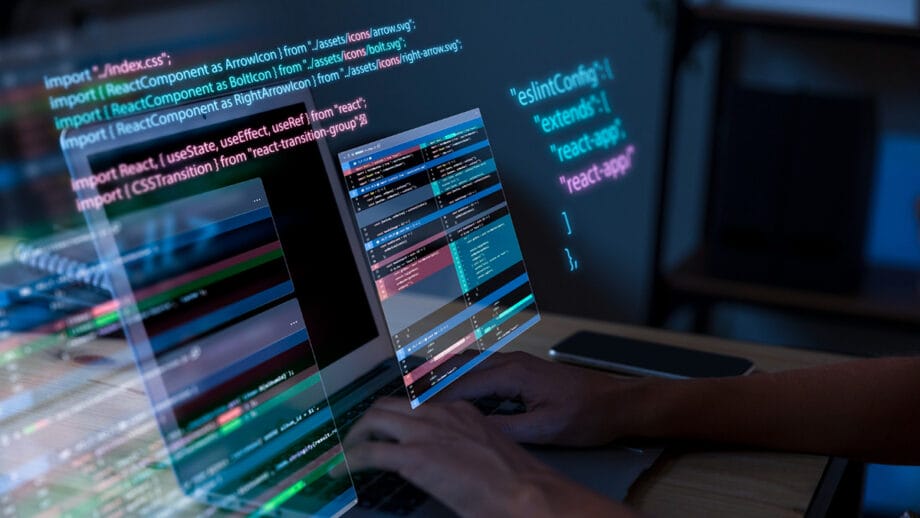A rich IT guy is a new city archetype based on career bias. However, the unpopular truth is that becoming a programmer is not the pick of the mountain, where you can rest on your laurels. This is the beginning of the lifelong road, full of new challenges and a constant need for improvement. You must always stay afloat and never stop mastering new trends. A professional changes along the profession. For a programmer, this journey is endless.
Since the Internet appeared, it has gone through different stages of development. Everything started with Web 1.0, where the only thing people saw was a static web page. But today, technology has developed to change everything from home management and learning to entertainment. Evolution has brought us to Web 3.0 supporting over devices. It already has almost everything a user needs, including elements of artificial intelligence and complicated, decentralized systems.
We are now quickly moving toward a new age of Web 4.0, a distant but already visible horizon. What awaits us in Web 4.0? None of us knows the endpoint, but this is going to be an era that can radically transform the Internet space. In this article, fantasize with us about what Web 4.0 will look like and how it will develop. We will also discuss what skills programmers need to develop to prepare themselves for the future of Web 4.0.
Introduction of the Evolution of the Internet

Year in and year out, the Internet develops to be a more intricate, creative, and essential component of existence. Historically, originally established as a means of conveying only pure textual information, the Internet has been through several stages of development as a network. These phases have each led to the introduction of new technologies, the generation of higher data velocities, and the enhancement of the interface.
There is no one better to explain this evolution than an experienced programmer who has to keep up with what is new all the time. We assure you the word go is not appropriate. One has it that the programming profession involves little work and that they are paid an enormously large sum of money. But the price for this popularity is high, namely competition. And, therefore, the need for acquiring new skills and knowledge increases. Now let us have a look at what has happened in the previous stages of the Internet.
Technologies of the Past or Web 1.0
Get ready to step back in time! At that time the global network started to emerge and the world was bending over waiting for new discoveries. Every website had a couple of basic HTML pages that the user could only read, but could not make changes to. This was not the Internet as you know it today. It was an environment of static web pages shared with a community of fellow students, without the opportunity to interact with anyone beyond the college.
Occasionally, such pages were referred to as “Readable Webs”. The most important thinkers of this period were sometimes referred to as “Dreamers.” Discussions about future technologies were all like they came right out of fiction stories. Programmers were then compared with the crazy explorers. This is what the start of the journey you have embarked on looked like.
The Era of Interaction
It is finally possible to step back from this story and analyze what happened when Web 2.0 replaced Web 1.0 in the 2000s. Home pages that were static turned into live refreshed content depending on the actions taken by the visitors. With the help of Web 2.0 sites, such as Facebook, Twitter, YouTube, etc. We have the opportunity not only to read the material but also to write it ourselves.
This way the era of social networks, blogs, online stores, and communication and entertainment services. For programmers, this era has become the most progressive. This profession has become more in demand and well-paid. In addition, it was Web 2.0 that brought the main baggage of knowledge and basic skills to novice specialists. Web developers began to improve the development of various web application capabilities, which included the use of frameworks and libraries such as Angular, and React.

Concepts of the Current Generation of the Internet
Technology never stands still, and soon Web 3.0 was born. This technology marked the next generation of the World Wide Web. It is artificial intelligence (AI), blockchain, semantic web, and decentralization. While Web 2.0 mainly focused on the dynamism in content sharing and content integration, Web 3.0 focused on making the Internet smart. This was useful for improving the recommendation system, search, and interaction with data.
In addition, Web 3.0 was seen to offer data protection methods, higher readability at the modern network level, and greater openness. To be more precise, Web 3.0 was a completely new way of programming that had never existed before.
What is Web 4.0?
We are already on Web 4.0. This is a concept of the future Internet that will contain even more complicated technologies. The network will use technologies such as:
- AI and machine learning: While Web 3.0 AI is only capable of analyzing and then processing data, Web 4.0 AI will directly interact with users, learn about them understand their needs, and predict them in advance.
- Augmented reality and virtual reality: In Web 4.0, both AR and VR will become essential tools for interacting with the Internet. Instead of receiving information on a monitor, users will be able to “immerse themselves” in a virtual world.
- The Internet of Things (IoT): This will make it possible to get trillions of things connected and controlled including smart homes, cars, wearables, manufacturing systems, etc. Web 4.0 devices will be able to send data as well as also interact with users based on the data analysis that is available.
- Blockchain and decentralization: Web 4.0 will add the development of blockchain with high security, transparency, and decentralization. We will be able to create new types of decentralized applications and services that will not require a central server and intermediaries, as is the case with blockchain.
What Web 4.0 is proposed to be: It should be a more integrated and personalized Internet that is largely self-regulating in nature. And it is no longer a simple means of exchanging information, but a system that will dictate the future of people’s lives. It helps make decisions and assist in actions in real-time.
The Impact of Web 4.0 on Programmers
Web 4.0 will open up new opportunities for programmers. However, this will require mastering many new technologies and tools. This is important to remain competitive specialists. Developing Web 4.0 will require deep knowledge in areas such as artificial intelligence, virtual reality, the Internet of Things, and blockchain. Stay tuned to dive deeper into this niche.

New Technologies and Tools for Development
With the development of the Internet and the transition to Web 4.0, new opportunities and potential for developers are emerging. Will all programmers be able to master new technologies? Software engineers will collaborate using powerful tools that guarantee the application of advanced concepts, including artificial intelligence, virtual reality, the Internet of Things, and blockchain.
Therefore, the demand for much more complex solutions is only increasing every year. Programmers have to find new solutions and ways to retain customers. To meet such needs, developers must be ready to master new tools and approaches that have emerged during this time. The following table shows the technology trends that will be used for development during the Web 4.0 period.
| Artificial Intelligence and Machine Learning: | TensorFlow, PyTorch, OpenAI GPT, Scikit-learn |
| Virtual and Augmented Reality: | Unity, Unreal Engine, AFrame, ARKit |
| Internet of Things (IoT): | Raspberry Pi, Arduino, MQTT (protocol), Node-RED |
| Blockchain: | Solidity, Ethereum, Hyperledger, Truffle |
Taken together, these technologies will significantly change the landscape of the Internet, and programmers should be prepared for the new challenges and opportunities that Web 4.0 will bring.
Decentralization and Smart Contracts
One of the most important trends in Web 4.0 will be decentralization. Programmers will develop decentralized applications (dApps) that use the blockchain to provide transparency, security, and automation. Smart contracts and cryptocurrencies will be integrated into everyday life, creating new opportunities for businesses and social infrastructure.
Security and Privacy Issues
With the development of Web 4.0, the importance of security and data protection will increase. Programmers will work to create systems that provide a high level of security and help users control their data. It will be important to maintain a balance between personalization and privacy protection.
Ready to Hear the Predictions for the Future?
Web 4.0 is expected to change the way people interact with the World Wide Web. It will be a hub for improved customized services, powered by AI. Through the web, the platform will be able to communicate with routine objects such as cars, smart devices, homes, etc. For programmers, the Internet will be much easier to use and navigate. Cooperating with AI will allow them to focus on creativity and leave the routine for algorithms.
Conclusion

Web 4.0 will open opportunities for both users and programmers. New abbreviations will rule the world: AI, AR, and VR will make the Internet more integrated and decentralized.
There are numerous opportunities for further development, creation of services, and interaction with users. It is important to know that in Web 4.0, success is not equal to the speed with which you can learn new technologies, but the speed with which you can weave them into the development of your application.





